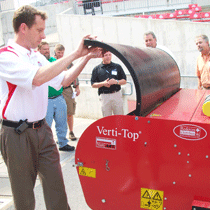By: Ron Hall

Brian Gimbel knows how to care for high-visibility turfgrass sports fields as the longtime sports field manager at Ohio Stadium, home of the The Ohio State University Buckeyes.
He’s been doing it for 18 years, since his student days at OSU. And he’s admittedly inclined to prefer turfgrass, which the team played on for 16 years until three years ago. But he says the synthetic turf surface (FieldTurf) at Ohio Stadium has reduced maintenance on the field considerably.
Or, in his words — “The best part of this new grass is that. . . I’m not stressing out.”
That stress mostly resulted from the vagaries of weather, which sometimes played havoc on delivering and maintaining a turfgrass field that could provide perfect (or near-perfect) playing conditions before a stadium holding 100,000-plus spectators and television audiences of millions. And, not to be forgotten, meeting the expectations of coaches and players, as well.
Addressing about 50 participants in a recent field day at the stadium hosted by the Ohio Sports Turf Manager’s Association, Gimbel said the monofilament field with its crumb rubber infill that’s now under his care requires “about a quarter as much maintenance” as the former Kentucky bluegrass field. He says much of that savings comes from not having to paint it.

Indeed, the field markings are crisp and the logos a brilliant scarlet viewed from any vantage point within the cavernous, 87-year-old stadium.
Gimbel’s maintenance regimen at the field is relatively simple. Why not? The field isn’t that intensively used, not compared to community fields, anyway. The Ohio Stadium field hosts the Buckeyes, of course, about six high school football games, band competitions and a few other assorted events, said Gimbel.
The main points of his maintenance program include running a magnet over the field to pick up any stray pieces of metal (perhaps from a player’s uniform) after every event, grooming the field with a Redexim-Charterhouse unit to get the monofilaments to stand straighter and level out the infill, and watering it “to settle the field.” His crew also applies a sanitary/anti-static agent to the field prior to games.
Said Gimbel, “This field has held up pretty well. The installers were great. They paid a lot of attention to detail.
Beyond typical maintenance procedures, Gimbel says the field’s surface is tested for hardness prior to and after each football game. The data is collected and shared with The Ohio State University sports turf team, which works closely with Gimbel and his squad on monitoring the field’s performance.
“We know this field is going to be here for a while and we want it to be the best that it can be for our athletes,” said Gimbel.

